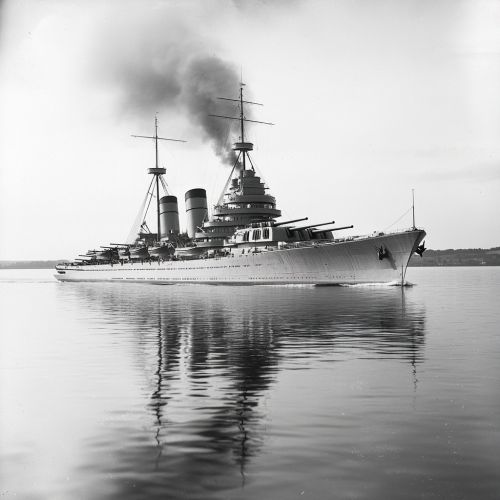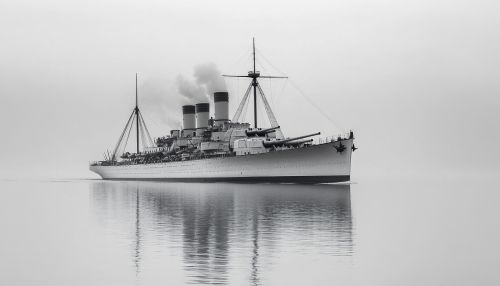SMS Lützow: Difference between revisions
(Created page with "== Design and Development == The SMS ''Lützow'' was a Derfflinger-class battlecruiser of the Imperial German Navy, constructed in the early 20th century. As part of the naval arms race preceding World War I, the ''Lützow'' was designed to be a formidable opponent to the Royal Navy's battlecruisers. The ship was named after Ludwig Adolf Wilhelm von Lützow, a Prussian general renowned for his role in the Napoleonic Wars. The design of the ''Lü...") |
No edit summary |
||
| Line 5: | Line 5: | ||
The design of the ''Lützow'' emphasized speed, firepower, and armor protection. The vessel was equipped with eight 30.5 cm (12 in) SK L/50 guns mounted in four twin turrets, providing significant firepower. The secondary armament consisted of fourteen 15 cm (5.9 in) SK L/45 guns and eight 8.8 cm (3.5 in) SK L/45 guns for defense against smaller vessels and aircraft. The ship's armor was designed to withstand hits from contemporary naval artillery, with a belt thickness of up to 300 mm (11.8 in) and deck armor up to 30 mm (1.2 in) thick. | The design of the ''Lützow'' emphasized speed, firepower, and armor protection. The vessel was equipped with eight 30.5 cm (12 in) SK L/50 guns mounted in four twin turrets, providing significant firepower. The secondary armament consisted of fourteen 15 cm (5.9 in) SK L/45 guns and eight 8.8 cm (3.5 in) SK L/45 guns for defense against smaller vessels and aircraft. The ship's armor was designed to withstand hits from contemporary naval artillery, with a belt thickness of up to 300 mm (11.8 in) and deck armor up to 30 mm (1.2 in) thick. | ||
[[Image:Detail-98549.jpg|thumb|center|A large battlecruiser sailing on calm waters, with visible gun turrets and smokestacks.|class=only_on_mobile]] | |||
[[Image:Detail-98550.jpg|thumb|center|A large battlecruiser sailing on calm waters, with visible gun turrets and smokestacks.|class=only_on_desktop]] | |||
== Construction and Commissioning == | == Construction and Commissioning == | ||
Latest revision as of 03:00, 19 October 2024
Design and Development
The SMS Lützow was a Derfflinger-class battlecruiser of the Imperial German Navy, constructed in the early 20th century. As part of the naval arms race preceding World War I, the Lützow was designed to be a formidable opponent to the Royal Navy's battlecruisers. The ship was named after Ludwig Adolf Wilhelm von Lützow, a Prussian general renowned for his role in the Napoleonic Wars.
The design of the Lützow emphasized speed, firepower, and armor protection. The vessel was equipped with eight 30.5 cm (12 in) SK L/50 guns mounted in four twin turrets, providing significant firepower. The secondary armament consisted of fourteen 15 cm (5.9 in) SK L/45 guns and eight 8.8 cm (3.5 in) SK L/45 guns for defense against smaller vessels and aircraft. The ship's armor was designed to withstand hits from contemporary naval artillery, with a belt thickness of up to 300 mm (11.8 in) and deck armor up to 30 mm (1.2 in) thick.


Construction and Commissioning
The keel of the SMS Lützow was laid down at the AG Vulcan Stettin shipyard in Stettin in 1912. The ship was launched on 29 November 1913, and after fitting out and sea trials, it was commissioned into the Imperial German Navy on 8 August 1915. The construction of the Lützow was part of Germany's strategic plan to challenge British naval supremacy and secure its maritime interests.
Operational History
Early Service
Upon commissioning, the Lützow was assigned to the I Scouting Group, the primary battlecruiser squadron of the High Seas Fleet. The ship's early service involved training exercises and patrols in the North Sea, as the German Navy sought to refine its tactics and maintain readiness for potential engagements with the British Grand Fleet.
Battle of Jutland
The most significant engagement involving SMS Lützow was the Battle of Jutland, fought from 31 May to 1 June 1916. As the flagship of Vice-Admiral Franz von Hipper, Lützow played a crucial role in the battle. The ship engaged British battlecruisers, including HMS Lion, and scored several hits, contributing to the damage inflicted on the enemy.
However, Lützow sustained severe damage during the battle. The ship was hit multiple times by heavy shells, resulting in flooding and a significant loss of buoyancy. Despite the crew's efforts to save the vessel, the damage proved too extensive. The decision was made to abandon the ship, and Lützow was scuttled by her crew to prevent capture by the British.
Technical Specifications
The SMS Lützow had a displacement of approximately 26,600 metric tons at full load. The ship measured 210.4 meters (690 ft) in length overall, with a beam of 29 meters (95 ft) and a draft of 9.3 meters (31 ft). The propulsion system consisted of four sets of Parsons steam turbines, powered by 14 coal-fired and 8 oil-fired Schulz-Thornycroft boilers. This configuration allowed Lützow to reach a top speed of 26.5 knots (49.1 km/h; 30.5 mph).
The ship's complement included 44 officers and 1,068 enlisted men. The battlecruiser's armor protection was comprehensive, with a main belt thickness of 300 mm (11.8 in), turret armor up to 270 mm (10.6 in), and deck armor ranging from 30 mm (1.2 in) to 80 mm (3.1 in).
Legacy and Impact
The SMS Lützow and her sister ships represented the peak of German battlecruiser design during World War I. The lessons learned from the Lützow's operational history influenced subsequent naval architecture and tactics, particularly in the development of later German capital ships.
The Lützow's participation in the Battle of Jutland highlighted the strengths and weaknesses of battlecruiser design, emphasizing the need for a balance between speed, firepower, and armor. The ship's loss underscored the vulnerability of battlecruisers to concentrated enemy fire, leading to changes in naval strategy and ship design in the post-war period.
